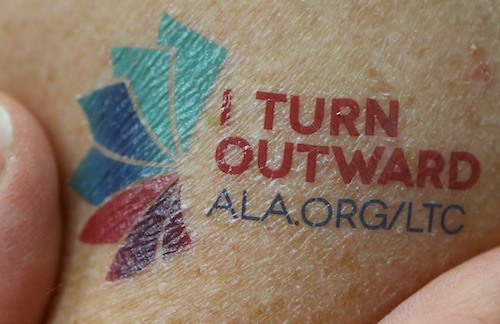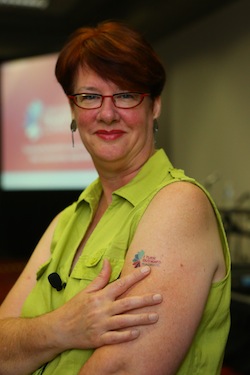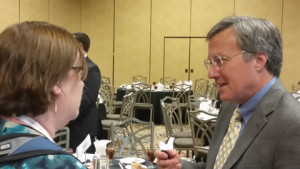
The first of four Annual Conference programs presented by the ALA Public Programs Office, “Turning Outward to Lead Change in Your Community: Aspirations,” introduced attendees to the concepts of the Harwood Institute and the ALA initiative—libraries transforming communities (LTC).
Facilitated by Cheryl Gorman, vice president of national programs at Harwood, the program explained that the idea of “turning outward” is not just a set of tools; according to Gorman, “It’s a mindset that helps you learn to do the good work you already do [but] better.”
Intended to refine attendees’ efforts at meeting the needs of their communities, the majority of the program was spent engaging in the practice of creating shared aspirations.
“If you turn outward and make very intentional choices and judgments, then we are going to be more effective and more relevant, and our communities will be more successful,” Gorman said.
So what does turning outward mean? It requires you to ask whether you’re looking at your community or your institution first when making decisions. Gorman said most of us are trained to think of our institution first, but this perspective flips that idea. “It’s really about how you start the conversation in the community,” she said. “So often today, work starts with an asset map or needs assessment, but it doesn’t give an idea of what the community’s and institution’s shared aspirations are.”
Although people often rally around a problem, Gorman stressed the importance of starting a conversation around the topic of aspirations because it is the beginning of engagement. “If you start with problems, you’ll never get off discussing them,” she said.
Participants took a few minutes to fill out an aspirations sheet, citing their aspirations for their community, challenges faced in achieving them, and what changes/new conditions would be necessary to achieve them.
The shared aspirations for this session were: embracing diversity social cohesion; creating a sense of community; and safety within communities.
Participants also discussed the challenges in reaching these aspirations:
- Isolation among subcommunities;
- Wealth distribution;
- Constraint of time versus urgency;
- A sense that someone else is going to take care of the problems;
- Getting more people to contribute;
- Lack of trust in officials;
- Lack of trust among community members/groups;
- Coming from a perspective of abundance versus a perspective of lacking.
Gorman explained that as the exercise goes on, the discussion goes from being extremely broad to more specific about people, their names, status, etc.
Creating a Harwood world in libraries
What new conditions would need to exist to address these challenges and reach our shared aspirations? Gorman reminded attendees that the conditions are not necessarily the flip of the challenge.
Some of the conditions participants listed included building trust, starting from the bottom up, finding the balance between economic development and environmental concerns, more empathy, making the community a priority for individuals (from a “me” to “we” attitude), change in the perception of newcomers, and acknowledging the role and equal importance of the “have nots” as the “haves” within a community.
To make this practice library-specific, Gorman suggested libraries ask themselves these four questions:
- What are the aspirations for the community at large?
- What are the challenges?
- What new conditions need to be created?
- And what is the library’s role in achieving these aspirations?
Gorman emphasized not selling oneself short in terms of your own power and suggested that the turning outward practice would be great for strategic planning.
See, hear, and read more about what’s going on at Annual—in real time and after.
Twitter: @alaannual and #alaac14
Facebook: https://www.facebook.com/events/489205011101981/
YouTube: http://www.youtube.com/user/AmLibraryAssociation
Flickr: http://www.flickr.com/groups/alaac14/
Pinterest: http://pinterest.com/alaannual/
Tumblr: http://ala-con.tumblr.com


